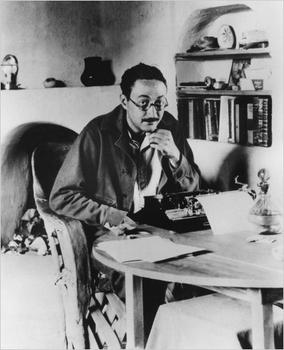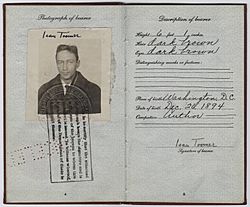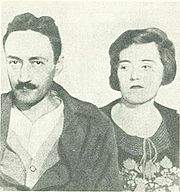Jean Toomer facts for kids
Quick facts for kids
Jean Toomer
|
|
|---|---|

Toomer circa 1920–1930
|
|
| Born | Nathan Pinchback Toomer December 26, 1894 Washington, D.C., United States |
| Died | March 30, 1967 (aged 72) Doylestown, Pennsylvania, United States |
| Occupation | Poet, novelist |
| Literary movement | Modernism |
| Notable works | Cane (1923) |
| Spouse |
Margery Latimer
(m. 1931; died 1932)Marjorie Content
(m. 1934) |
| Children | 1 |
| Signature | |
Jean Toomer (born Nathan Pinchback Toomer; December 26, 1894 – March 30, 1967) was an American writer. He is famous for his novel Cane (1923). This book is often linked to the Harlem Renaissance, a time when Black artists created amazing works. However, Toomer preferred to be known simply as "American." He did not want to be put into one racial group. Later in his life, he became a follower of the spiritual teacher G.I. Gurdjieff and then joined the Religious Society of Friends (Quakers).
Toomer kept writing poems, short stories, and essays. After his second marriage in 1934, he moved to Doylestown, Pennsylvania. There, he became a Quaker and lived a more private life. His writings are now kept at Yale University.
Contents
Growing Up
Jean Toomer's father left his mother and him when he was very young. His mother, Nina, divorced his father and moved back to Washington, D.C. to live with her parents. Toomer's grandfather wanted him to have a different name, so he started calling him Eugene. Toomer had many nicknames from his family. He only saw his father one more time before his father died in 1906.
As a child in Washington D.C., Toomer went to schools for Black students. When his mother remarried, they moved to New Rochelle, New York. There, he went to a school for white students. After his mother died in 1909, when he was 15, Toomer returned to D.C. He lived with his grandparents again. He finished high school at M Street High School, which was a well-known Black high school.
His Education
Between 1914 and 1917, Jean Toomer went to six different colleges. He studied many subjects like farming, fitness, and history. But he never finished a degree at any of them. He read many books by famous poets and writers. The talks he heard in college helped shape his own writing.
His Career
After college, Toomer went back to Washington, D.C. He wrote and published some short stories. This was a time of big changes in society after World War I. He worked in a shipyard for a few months in 1919. This year was called Red Summer because of many conflicts in cities. But it was also a time when many new artists were creating.
Toomer spent eight months studying Eastern philosophies. He stayed interested in these ideas for a long time. Some of his early writings were about politics. He published three essays in a newspaper called New York Call. His work was part of new movements in New York. In 1919, he started using "Jean Toomer" as his writing name.
As an adult, Toomer did not want to be called Black or white. He wanted to be seen as just "American." He had lived in both Black and white communities. He did not like being called a "Negro writer." He only let his publisher use that term for his book Cane to help sell more copies. This was because many people were interested in new Black writers at the time.
Many people have talked about Toomer's views on race. He wanted to go beyond simple definitions of race. He believed he was part of a new kind of American person, a mix of different backgrounds. He was one of the first writers to think that having some Black family did not mean you had to be only Black.
In 1921, Toomer worked for a few months as a principal at a school for Black students in Sparta, Georgia. This school was in a rural area. It was near where his father had lived. Toomer learned about his father's past there. He saw the lives of Black people in the Deep South, including how they were separated by race. This time made Toomer feel more connected to his African American heritage.
During this time, Black men faced violence in Georgia. The state had laws that made it very hard for Black people to vote. Many Black people were also leaving the South to find work in the North. This was called the Great Migration. Toomer started writing about his experiences in Georgia. He sent a story called "Georgia Night" to a magazine in New York.
Toomer then returned to New York. He became good friends with Waldo Frank. Frank helped him with his novel Cane.
About Cane
While Toomer was a principal in Georgia, he wrote stories, sketches, and poems. These became his famous novel Cane, published in 1923. The book was well-liked by both Black and white critics. Many famous Black artists praised Cane, including Langston Hughes.
Cane has three main parts. The first part is about the Black experience in the Southern countryside. The second part is about city life in the North. The last part is a story called "Kabnis." Many people thought Cane was a deep look into the minds of Southern people. Toomer was one of the first writers to mix folk culture with modern art.
The book was printed again in 1969, after Toomer died. People now see Cane as a look at social classes and how secrets and mixed-race families played a role. Toomer said he was inspired by other books like Winesburg, Ohio (1919). He also admired T. S. Eliot and wanted to be part of a group of American writers who were trying to make society better.
Many experts believe Cane is Toomer's best work. It is seen as an important book for both the Harlem Renaissance and modern writing. But Toomer did not want to be called a "Negro" writer. He wrote to his publisher, "My racial make-up and my place in the world are things only I can decide." It became harder for Toomer to get his work published in the 1930s during the Great Depression.
Later Writings
In the 1920s, Toomer became very interested in the ideas of George Ivanovitch Gurdjieff, a spiritual leader from Russia. Toomer traveled to France several times to study with Gurdjieff. He was a student of Gurdjieff until the mid-1930s. Much of his writing from this time was about his spiritual journey. He no longer wrote about African American characters. Some people think Toomer stopped writing as much because he struggled with how society wanted to label his race. Many other artists also studied with Gurdjieff through Toomer.
Toomer continued his spiritual search. He traveled to India in 1939. He also studied the ideas of Carl Jung and Edgar Cayce. Later, he looked into Scientology. But he always returned to Gurdjieff's ideas.
Toomer wrote only a little fiction later in life. He mostly published essays in Quaker magazines. He spent most of his time helping Quaker groups and working with high school students.
His last major work published while he was alive was Blue Meridian. It was a long poem about the potential of the American people. He stopped writing for the public after 1950. But he kept writing privately, including his own life story and a book of poems. He passed away in 1967 after being sick for several years.
Marriage and Family Life
In 1931, Toomer married writer Margery Latimer in Wisconsin. Their marriage caused a lot of talk in the newspapers because she was white and he was seen by many as Black. Some people strongly criticized Toomer for marrying a white woman.
Margery Latimer was a respected writer. She died in August 1932 while giving birth to their first child. Toomer named their daughter Margery in her memory.
In 1934, Toomer married for a second time to Marjorie Content. She was a photographer from a wealthy family in New York. This marriage also got attention because Toomer was a known writer and Marjorie was white. In 1940, the Toomers moved to Doylestown, Pennsylvania. There, he officially joined the Quakers and started to live a more private life. Toomer wrote a lot about relationships between men and women from 1935 to 1940. His ideas were shaped by his Gurdjieff studies.
In 1939, Toomer changed his name again to "Nathan Jean Toomer." He wanted to show his male side and perhaps connect more with his father's family. His friends still called him "Jean."
His Views on Race
Toomer had a mixed background and his appearance did not clearly show one race. He lived in both Black and white communities as he grew up and as an adult. He did not want to be limited by race. He saw himself as an "American," representing a new, mixed culture. Because of his wide experiences, he did not want to be called a "Negro writer." However, his most famous book, Cane, was inspired by his time in the rural South and explored the early African American world of his father.
Some experts believe that Toomer sometimes lived as a white person. But he never said he was white or Black. He always said he was simply American. In some official records, he was listed as white, and in others, as "Negro." When he married Margery Latimer, the license listed both as white. Other experts do not fully agree with these ideas. They say Toomer was trying to break down racial barriers. One expert said, "If people didn’t ask, I expect he didn’t tell."
Jean Toomer did not like clear racial labels. He wanted to be known only as “American.” His feelings about race fit with his interest in Quaker ideas. He attended Quaker meetings in Doylestown and later joined a group there.
Quakerism brings together people with different beliefs. They encourage everyone to understand themselves. Jean Toomer's Quaker beliefs are linked to his writings about the place of African Americans in the 20th century. He also wrote essays about Quakerism. In one essay, “The Negro Emergent,” Toomer described how African Americans were rising above old ideas that only saw them as slaves. He said they were working to find their own voice.
His Legacy
- Toomer's writings and unpublished works are kept at the Beinecke Library at Yale University.
- When Cane was printed again in 1969, it was called a "Black Classic." This made people interested in Toomer's work again.
- Since the late 1900s, collections of Toomer's poems and essays have been published.
- In 2002, Toomer was chosen for the Georgia Writers Hall of Fame.
Books by Jean Toomer
- Cane (New York: Boni and Liveright, 1923) ISBN: 0-87140-151-7
- Problems of Civilization, by Ellsworth Huntington, Whiting Williams, Jean Toomer and others, (New York: D. Van Nostrand Co., 1929)
- Essentials: Definitions and Aphorisms (Chicago: Lakeside Press, 1931)
- An Interpretation of Friends Worship (Philadelphia: Committee on Religious Education of Friends General Conference, 1947)
- The Flavor of Man (Philadelphia: Young Friends Movement of the Philadelphia Yearly Meeting, 1949)
- The Collected Poems of Jean Toomer (Chapel Hill: University of North Carolina Press, 1988) ISBN: 0-8078-4209-5
Images for kids
-
Drawing of Toomer by Winold Reiss (c. 1925). This drawing is at the National Portrait Gallery.
See also
 In Spanish: Jean Toomer para niños
In Spanish: Jean Toomer para niños
- List of African American writers
- Literature of Georgia (U.S. state)





